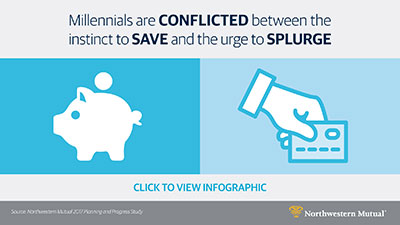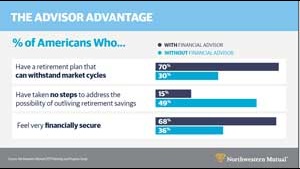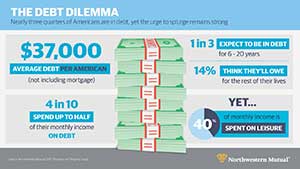
Planning & Progress Study 2017
The 2017 Planning and Progress Study seeks to provide unique insights into U.S. adults’ attitudes and behaviors towards money, financial decision making, and the broader landscape issues impacting people’s long-term financial security.
The study is based on an online survey of 2,749 U.S. adults conducted from February 14-22, 2017 (2,117 interviews with U.S. adults age 18+ in the General Population and an oversample of 632 interviews with U.S. Millennials age 18-34). Data were weighted to be representative of the U.S. population (age 18+) based on Census targets for education, age/gender, race/ethnicity, region and household income.
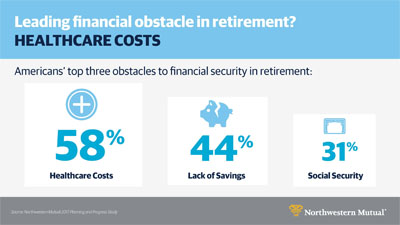
Americans view healthcare costs as the leading obstacle to financial security in retirement, according to new data from Northwestern Mutual’s 2017 Planning & Progress Study. In fact, the number of Americans citing healthcare costs as their chief concern spiked dramatically from 45% in 2016 to 58% this year. Lack of savings (44%) and Social Security uncertainty (31%) followed healthcare costs to round out the top three.
The research released today is part of Northwestern Mutual’s 2017 Planning & Progress Study – an annual research project exploring Americans' attitudes and behaviors toward finances and planning.
Social Insecurity
Findings indicate that the continued existence of Social Security as a retirement safety net is increasingly weighing on Americans. For the first time this year, Social Security edged out lack of planning to become the third cited obstacle to financial security in retirement. Additionally:
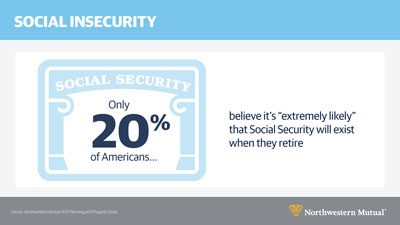
- Only 2 in 10 (20%) Americans believe it’s “extremely likely” that Social Security will be available when they retire
- Women are the least optimistic, with nearly 6 in 10 (59%) saying Social Security is “not at all likely” or “somewhat likely” to exist compared to 52% of men. This is noteworthy given that 4 in 10 women expect to rely on Social Security as their “only” or “primary” source of income in retirement
Dangerous disconnects?
Despite growing anxiety about retirement costs, the future availability of Social Security, and insufficient retirement savings, this year, fewer Americans said there is some chance of outliving their savings --- down to 62% from 69% in 2016.
However, further data contradict this optimistic outlook:
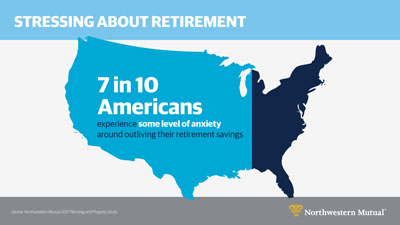
- 7 in 10 Americans experience some level of anxiety around outliving their retirement savings
- Less than half (47%) of Americans feel very financially secure and nearly 2 in 10 expect to feel less secure over the next 12 months
- Under one third (31%) believe they excel at contributing to retirement savings
- 4 in 10 (43%) believe there is more than a 25% chance of outliving their savings entirely
Northwestern Mutual’s 2017 Planning & Progress Study reveal that Millennials are caught in a tug-of-war between their long-term financial aspirations and the lure of spending now. Balancing these competing priorities are resulting in heightened levels of anxiety that are impacting Millennials’ physical, professional, and social well-being.
Determined to prepare for the future
Though in the early stage of their financial lives, Millennials are outpacing older generations in taking important steps toward securing their financial future. Notably:
- Nearly two thirds of Millennials (64%) recognize that they need a financial plan that anticipates up and down cycles compared to 55% Gen X and 43% Boomers
- Nearly 1 in 4 (23%) view themselves as “highly disciplined” financial planners (compared to 15% Gen X an 19% Boomers) but are still substantially more likely than Gen X and Boomers to say that their financial planning needs improvement (82% Millennials relative to 71% Gen X and 54% Boomers)
- Millennials, more than other generations, view “starting to save early” as a financial best practice where they excel (34% Millennials, 24% Gen X, 17% Boomers)
Temptations colliding with best intentions
Interestingly, further findings reveal a flipside to Millennial financial prudence, indicating that Millennials are more likely to give in to the urge to splurge more frequently than other generations:
- One third (32%) of Millennials say they’re prone to “excessive or frivolous spending” (relative to 26% Gen X and 19% Boomers)
- Nearly 1 in 3 (31%) Millennials say they have spent money budgeted for other things on themselves – more than twice Gen X (15%) and almost eight times more than Boomers (4%)
- Nearly 1 in 4 (23%) said they have hidden purchases from a spouse or partner versus 17% Gen X and 8% Boomers
Balancing act takes a physical and emotional toll
The pressure of trying to meet competing financial and lifestyle priorities appears to be making Millennials significantly more professionally and financially anxious than other age groups. More than half (53%) of Millennials experience high to moderate anxiety about losing their job, compared to less than a third of Gen Pop (29%). The same is true for level of savings (67% Millennials vs 50% Gen Pop) and income (69% Millennials vs 48% Gen Pop).
And the financial stress Millennials are feeling is having a pronounced impact on their health, careers and social lives:
- 28% say that anxiety impacts their job performance daily, weekly or monthly – more than twice the rate of Gen Pop (12%)
- Nearly one quarter (23%) say financial anxiety makes them physically ill weekly or monthly compared to just 12% Gen Pop
- Nearly 2 in 10 (18%) feel depressed due to financial anxiety on a weekly basis (twice as often as Gen Pop – 8%)
- 24% say financial anxiety affects their relationship with a spouse/partner hourly, daily or weekly (10% Gen Pop) while a similar number says it has caused them to miss social events and opportunities (25% Millennials, 10% Gen Pop)
Seven in 10 (70%) American adults aged 18+ consider themselves part of the middle class, according to new findings from Northwestern Mutual’s 2017 Planning & Progress Study. This compares interestingly to analysis of government data by the Pew Research Center showing that the number of middle-income households in the United States has been dropping for four decades, and made up only 50% of the U.S. adult population in 2015, down from 61% in 1971.
The key to that discrepancy may lie in the way Americans perceive what it means to be part of the middle class. According to the Northwestern Mutual study:
- 84% of American adults say that one defining element of the middle class is based on income or assets. More than half of those who identified as middle class in the study have household incomes ranging from $50,000 to $125,000 annually.
- 70% of Americans say that lifestyle and perspective are also defining elements of the middle

View the Full Size Infographic
Optimism and Financial Responsibility
The middle class in America stands out from the general population in a few key areas. Most notably, they have greater near- and long-term economic optimism, and strong financial habits. The 2017 Planning & Progress Study found that people who identify with being part of the middle class are:
- More likely to believe in the attainability of the American Dream (55% vs 48% of the general population)
- More optimistic about the US economy this year than in 2016 (47% vs 43% of the general population)
- More likely to have a clear and accurate view of their financial picture (71% vs 64% of the general population)
- More likely to work with an advisor (43% vs 35% of the general population)
- More likely to have a retirement plan that has been created to withstand market cycles (51% vs. 43% of the general population); and
- More likely to feel very financially secure (58% vs. 47% of the general population)
Mobility
The 2017 Planning & Progress Study provides a snapshot of mobility into and out of the middle class among Americans. According to the research:
- Single Americans are less likely to consider themselves middle class -- 57% of single men and 59% of single women say they’re middle class vs 85% of non-single men and 74% of non-single women. Additionally, the overall percentage of single Americans in the middle class dropped fairly significantly in the last five years -- 67% of single men and 62% of single women said they were middle class five years ago compared to 57% and 59% respectively who say the same today.
- Most mobility into the middle class has been upward -- Among those who say they are middle class today but weren’t five years ago 8 in 10 say they were either “lower middle class” (40%) or “low income” (43%)
- The middle class majority spans generations -- Americans were far and away most likely to say their parents were middle class (44% vs. 27% who said lower middle class, 14% who said low income, 13% who said upper middle class and 2% who said wealthy)
- Overall numbers are flat -- 70% of Americans consider themselves middle class today, and a nearly identical number (71%) thought they were middle class five years ago.
Download the 2017 Planning and Progress Study - The U.S. Middle Class
New findings from Northwestern Mutual’s Planning & Progress Study revealed that Americans who receive guidance from financial advisors feel markedly more prepared for retirement. According to the data:
- 7 in 10 (70%) Americans with advisors said their retirement plan is designed to withstand market cycles compared to 30% of those who do not use an advisor
- Nearly all those with an advisor (92%) have discussed retirement with someone relative to just have 51% of those without an advisor
- People without financial advisors are twice as likely (53%) as those with advisors (27%) to view lack of savings as an obstacle to financial security in retirement
- 49% of people without an advisor have taken no steps to address the possibility of outliving retirement – three times as many as those with an advisor (15%)
Financial Advice – the key to confidence and the antidote to anxiety?
In addition to a heightened level of retirement readiness, Americans who use advisors tend to feel more financially confident overall. Notably, individuals with financial advisors are almost twice as likely as those without advisors to say they feel “very financially secure” (68% vs 36%). Additionally, more than three quarters (77%) view themselves as “highly disciplined” or “disciplined” planners compared to 41% of those without an advisor. Good financial habits may be a key reason why people with advisors experience significantly less anxiety about debt, income, poor credit, and unplanned health or financial emergencies.
This optimistic outlook extends beyond personal finances:
- More than half (52%) of U.S. adults with advisors think the economy will be better this year compared to just 39% of those without advisors
- 6 in 10 (59%) of people with advisors believe that the American Dream is still attainable to most while only 4 in 10 of those without an advisor feel the same
And the data suggests that Americans are increasingly embracing the value of professional financial advice. This year there was incremental growth in the number of Americans with an advisor (35% up from 31% in 2016). The uptick was particularly pronounced within the Millennial generation, with 29% currently using a financial advisor versus 21% in 2016.
Download the 2017 Planning and Progress Study — Advisor Advantage
Nearly three quarters of Americans are struggling with debt and the burden is significant in terms of both size and duration, according to new findings from Northwestern Mutual’s 2017 Planning & Progress Study. Specifically:
- Of those Americans with debt, 4 in 10 (45%) spend up to half of their monthly income on debt repayment
- Nearly half of Americans (47%) are carrying at least $25,000 in debt, with average debt of $37,000 excluding mortgage payments. Notably, more than 1 in 10 say their debt exceeds a staggering $100,000
- More than one third (36%) said they will be in debt between 6 and 20 years while 14% expect to be in debt for the rest of their lives
When looking at the sources of debt, similar to 2016, mortgages (29%), credit card bills (19%), and personal educational loans (7% gen pop and 23% for Millennials) topped the list.
The True Cost of Debt
Not surprisingly, debt emerged as a significant source of stress and pressure:
- 4 in 10 Americans said debt has a “substantial” or “moderate” impact on financial security and the same number consider it a “high” or “moderate” source of anxiety
- Eliminating all debt (26%) and earning significantly more income (29%) had the most mentions when asked what changes would most positively affect people’s financial situations
- When asked how they would use a $2,000 windfall, 40% said they’d pay down debt
Despite recognizing the downsides of debt, the lure of spending remains strong. After covering off on necessities, Americans said 40% of their monthly income goes toward discretionary spending on entertainment, leisure travel, hobbies, etc. In fact, when asked what financial pitfalls they are prone to, one quarter of Americans flagged “excessive/frivolous” spending.
Paying the Piper – Or Not
The findings revealed that, among those managing debt, there is no clear consensus on the best strategy for repayment:
- “I pay as much as I can on each of my debts each month” (35%)
- “I pay off debts with the highest interest first and make minimum payments to others” (19%)
- “I pay what I can when I can” (18% gen pop - 25% Millennials)
- “I make minimum monthly payments to each creditor” (17%)
Download the 2017 Planning and Progress Study – The Debt Dilemma
While Americans feel like the country is currently on firmer financial footing today, overall confidence appears to have waned, according to new research released by Northwestern Mutual. The study found:
- 43% of U.S. adults 18 and over say the economy will be better this year than in 2016, which is a considerable jump from the 31% who said the same last year; and
- Nearly three quarters (72%) of Americans feel financially secure.
These positive signals, however, were tempered by a more sober long-term outlook. Today, less than half (48%) of U.S. adults aged 25-65 say the American Dream is still attainable for most Americans, compared with 58% who said the same in 2009 – the first year of the study.
Financial Vulnerability
The 2017 Planning & Progress Study suggests that while Americans still feel a high degree of financial vulnerability, there are some signs of improvement over last year:
- The majority (67%) of U.S. adults 18 and over believe that, over time, there will likely be more financial crises. While the number is high, it’s a sharp decline from the three-quarters (76%) who said the same in 2016.
- 43% of U.S. adults say the economy will be better this year than in 2016, versus 31% who said the same last year.
- 72% feel financially secure. And more than a third (38%) expect their financial security to increase in the next year, which is double the number (19%) who expect to feel less secure.
- Still, more than one in four (28%) Americans feel a level of financial insecurity, and more than one in ten (11%) feel “not at all secure.”
Financial Habits
Just as Americans are feeling slightly better about the country’s economic footing, there are signs that their financial discipline has slipped. Despite widespread expectations that financial crises are likely to occur again, people have taken a small step backwards in terms of their long-term financial planning. The study found:
- Only 50% of U.S. adults 18 and over say they need a plan that anticipates up and down cycles. This is a drop from the 57% who said the same last year.
- Only 41% say their long-term savings strategy has a mix of high and low-risk investments, compared to 44% last year.
Download the 2017 Planning and Progress Study – Financial States of America
